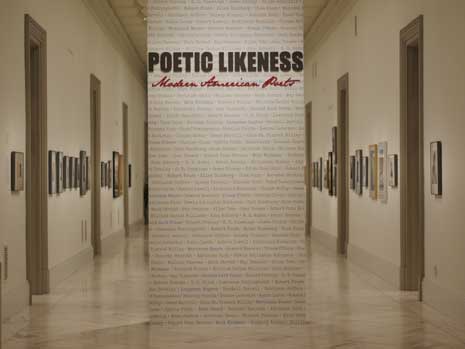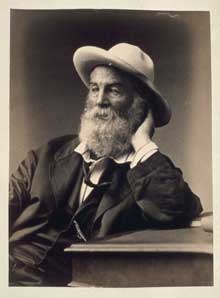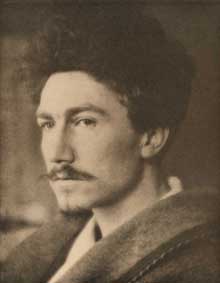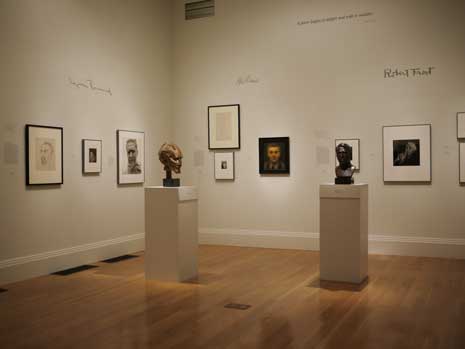Poetic Likeness: News That Is Staying News

As Ezra Pound noted, “Poetry is news that stays news.” The National Portrait Gallery’s new exhibition, “Poetic Likeness: Modern American Poets,” is a celebration of the American poet that is currently making exciting news. We recently spoke with exhibition curator David C. Ward.
Q: Our readers will recognize you from your previous work—“Walt Whitman: a kosmos,” “Hide/Seek: Difference and Desire in American Portraiture,” and “One Life: The Mask of Lincoln.” Can you tell our reading audience a little about why you wanted to curate this exhibition?
DW: I started getting interested in poetry, both as a scholar and as a writer, in the late 1980s. As I worked on poetry and American culture—I was moving in a more American Studies-ish direction: I was becoming more interested in the interrelationships of art, literature, and history.
It just seemed a natural fit for NPG to do an exhibition that would recognize the role of poets in the creation of American culture—as well, of course, to measure their contributions to poetry itself as an art form.
And in terms of the art of portrayal, the link between poets and artists has always been close, so an exhibition on poets would be an index to the evolution of modernist American art, particularly modernist photography; photographs make up the bulk of the images in “Poetic Likeness.”
Q: You are a widely published poet [Ward’s work has been published in many journals, and his collection, Internal Difference, was published in 2011 (Manchester, England: Lintott/Carcanet)]. How did you employ your criteria for poetry—that is, what you consider to be influential work—in picking the works for your show? Or did you?
DW: Well, I’m not really widely published as a poet! But I have a pretty good understanding of the history of poetry, the interrelationships between poets as the art form evolved, and the relationship between poetic writing and modernism.
The major question in thinking about “Poetic Likeness” was to come up with a time frame that would be coherent and interesting. For logistical reasons, the exhibition is based on our permanent collection. By far the strongest part of that collection when it comes to poetry is the modern era: roughly 1900 to the mid-1970s. We do have some earlier American poets, and I guess I could have done a “forerunner” room that included Joel Barlow or the poets in the Victorian era, which culminated with Longfellow. I just decided it made for a cleaner exhibition if it homed in on the modern era.
Conversely, I didn’t want to get too far beyond the 1970s into contemporary poets, because I think the cultural climate changes dramatically after the mid-1970s. Contemporary portraits would make up another exhibition entirely.
Q: Did you include a couple of poets you had second guesses about? That is, did you have any last minute epiphanies, or wake up in the middle of the night and say, “HD! I must have an imagist and she's the one—?”
DW: Not really. I was constrained by who we have in the collection. I recognize that there are poets who are missing, and I expect to get e-mails from people whose favorite poet isn’t represented. I did debate whether I should start with Longfellow or not, but I thought that would skew the show toward what came before by contrasting Longfellow with Whitman.
I admire Longfellow for his professionalism and the way that he competed, if that’s the word, with his English contemporaries—he did put American poetry on the map. But he is fundamentally a Victorian. So I started with Whitman who, as Pound wrote, “broke the new wood,” creating a poetry on which subsequent writers would build.
Q: You use “modern” in the title of your exhibition. How do you link Walt Whitman with all that is modern?
DW: I think Whitman is the key figure in American literature—well, maybe along with Emerson—and in Leaves of Grass he alters the cultural landscape by almost literally including the landscape of nineteenth-century America: he breaks with the genteel tradition and brings the street into the parlor.

Albumen silver print, 1872 / National Portrait
Gallery, Smithsonian Institution; gift of Mr. and
Mrs. Charles Feinberg
With Whitman (right) we hear, refracted poetically, the language of actual Americans—the voice of the street—and see the turbulent society of which he was a part. He opens everything up. And he creates a particular style of poetry—free verse—that breaks the constraints of formal poetry based on iambic pentameter and other “rules.” He kicks down the door, as he himself puts it.
So his influence is incalculably liberating. But it takes Ezra Pound to mold and fashion all the raw, sometimes incoherent writings of Whitman into a sophisticated, modern poetry that was responsible to the art itself and on which an American poetic tradition could be built.
Q: Ezra Pound was widely disliked after World War II, but his poetry has no small amount of sway over poets and students these many decades beyond his death. Was your choice to put him in this show a “no-brainer,” or did Pound's politics enter the curatorial process?
DW: No, to paraphrase one of Donald Rumsfeld’s “rules,” you do history with the history you have: we are not in the business at the Portrait Gallery of just validating people we agree with. So putting Pound in—indeed giving him a formative position—was, as you say, a “no brainer.” Pound’s career is tremendously interesting and important, regardless of how we view his evolving political career and his activities in World War II.

Collotype print, 1913 / National Portrait Gallery,
Smithsonian Institution
For those who don’t know the story: Pound (right), who spent most of his life overseas, lived in Italy during World War II, and he made a series of inflammatory broadcasts in favor of the Fascist cause during the war.
Pound was imprisoned after the war, effectively as a war criminal, and he ran a real risk of being tried for treason and even executed, as other wartime propagandists, Lord Haw-Haw and Tokyo Rose, were.
I don’t think there was any real appetite for putting Pound on trial, and instead he was declared mentally unstable and incarcerated in St. Elizabeths for most of the 1950s. I don’t know if he was insane, but he certainly was broken by being imprisoned.
But what needs to be remembered is not how he ended his career but how he began it: not only as a great poet in his own right but as someone who had tremendous influence in creating the first generation of modern American poets. He was a very generous supporter of poets who differed widely in temperament and style, from Hilda Doolittle to Robert Frost. He famously edited T. S. Eliot’s The Waste Land, probably the greatest modern poem, and Eliot dedicated it to him as il miglior fabbro: the better maker.
So I think we have to recognize that even as we are clear-eyed about his faults. I think Americans tend to be a bit sentimental about history: they think that people have to be “good guys,” when history itself tells us that personal character frequently has nothing to do with achievement! But that’s another story . . .
Q: What projects are you working on now?
DW: Short term, i.e., for the life of “Poetic Likeness,” I am working on programming. In particular I want to organize a reading by major American poets to take place at the NPG sometime in April—National Poetry Month!—just before the exhibition closes. And there will be other, smaller poetic events. So watch this space.
Also, I have another very interesting poetry project which is that I coedited, with our curator Frank Goodyear: a small book called Lines in Long Array, which is part of the Smithsonian’s programming about the Civil War. What Frank and I did was to commission twelve contemporary poets to write about the war in any way that they chose to do so. We then paired those poems with twelve poems from the war years themselves, including work by Herman Melville, Emily Dickinson, and Walt Whitman. Plus we included modern photographic landscapes by the artist Sally Mann that are set off against photographs from the war by Alexander Gardner.
It’s a really nice book, and the poems we commissioned turned out wonderfully well. Really looking forward to seeing it through print— it should be out by the fall of 2013.


